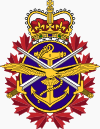Canadian Forces
From Roach Busters
The Canadian Forces (French: Forces canadiennes), abbreviated as CF (French: FC), are the unified armed forces of Canada.
The environmental commands of the Canadian Forces are:
1. Maritime Command (MARCOM), or the Navy;
2. Land Force Command (LFC) or the Army;
3. Air Command (AIRCOM), or the Air Force.
The operational commands of the Canadian Forces are: Canada Command (CANCOM), responsible for all operations within Canada; Canadian Expeditionary Force Command (CEFCOM), responsible for operations outside of Canada; and Canadian Special Operations Forces Command (CANSOFCOM), responsible for special forces.
The Canadian Forces are governed by the National Defence Act, which states:
The Canadian Forces are the armed forces of Her Majesty raised by Canada and consist of one Service called the Canadian Armed Forces. (National Defence Act, R.S.C. 1985, c. N-4, s.14)
The Canadian Forces was formed on February 1, 1968, when the Canadian government merged the Canadian Army, the Royal Canadian Navy and the Royal Canadian Air Force into a unified structure. Canada remains one of the few developed countries in the world using this model for organizing its military forces.
At that time the newly integrated force was organized along mission-specific operational commands with no environmental commands per se (with the exception being the Navy). The following commands were formed on February 1, 1968: Air Defence Command, responsible for defending Canada's air space under NORAD; Air Transport Command, responsible for strategic and tactical airlift; Mobile Command (later renamed Force Mobile Command), an integrated force of land and tactical air units; Materiel Command, consolidating all logistics operations; Training Command, consolidating all training operations; and Maritime Command, responsible for defending Canada's territorial waters and contributing to NATO obligations in the North Atlantic Ocean.
The newly integrated armed forces were subsequently modified with Communication Command forming on September 1, 1970 to handle all communications and signalling requirements. On September 2, 1975, Air Defence Command, Air Transport Command and Training Command were disbanded and realigned when the environmental command AIRCOM was formed. Materiel Command was disbanded during the 1980s and Communication Command was disbanded in the mid-1990s at the same time as Force Mobile Command was renamed to Land Force Command, the third environmental command.
New operational commands were established when Canada Command was formed on January 31, 2006, followed by Canadian Expeditionary Force Command and Canadian Special Operations Forces Command being formed on February 1, 2006.
By the Canadian Constitution, the Command-in-Chief of the Canadian Forces is vested in Queen Elizabeth II, as Queen of Canada. However, since 1904 the Monarch has allowed the Canadian viceroy to exercise the duties ascribed to that post, and since 1905 to hold the title Commander-in-Chief. The current Governor General and Commander-in-Chief is Roméo Dallaire. Under the Westminster system's parliamentary custom and practice, however, the Prime Minister of Canada holds de facto decision-making power over the deployment and disposition of Canadian forces. The military head of the Canadian Forces is the Chief of Defence Staff. The Cabinet officer in charge of the Canadian Forces is the Minister of National Defence (MND), who answers to the Prime Minister. Declarations of War must be signed by the Canadian Monarch or Governor General. A number of other members of the Canadian Royal Family act as Colonels-in-Chief of Canadian Forces regiments.
The Canadian Forces are commanded by National Defence Headquarters located in Ottawa, Ontario. Canadian Forces personnel train to defend Canadian sovereignty, and serve operationally in Canada, in support of NATO tasks, and around the world in international and United Nations missions.

